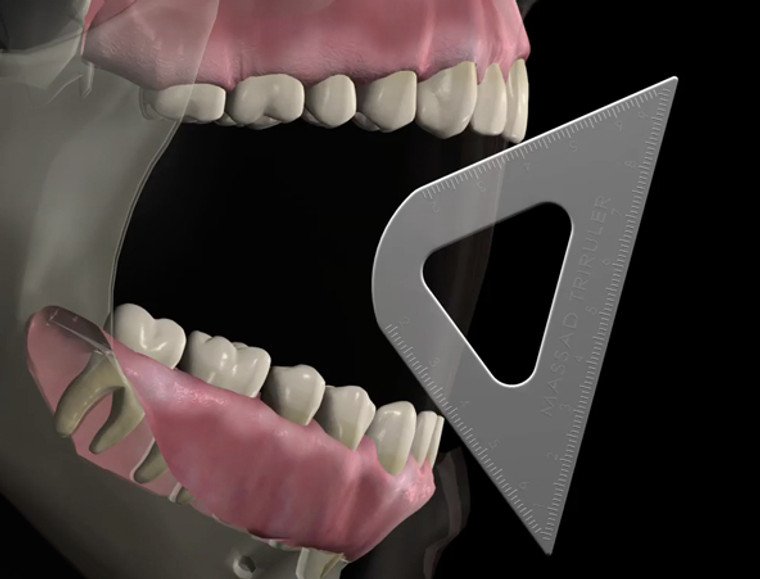Massad® TriRuler, 12-pk
Massad ProductsMassad TriRuler, 12-pack
The Massad TriRuler is a multi-use measuring tool for evaluating edentulous, dentate, and partially dentate patients. The ruler is triangular shaped and constructed of clear autoclavable plastic. The apex of the triangle is rounded, for patient comfort and safety. The base of the triangle is a 10-centimeter ruler, scored in 1-millimeter increments.
The sides of the Tri-ruler are scored for measuring across the width of the triangle, by matching the numerical values on each side. It should be noted that the scored measuring marks on the sides of the tri-ruler are not linear measurements: that is, these marks are not used as a millimeter ruler.
The primary use of the ruler is to measure the patient’s maximum oral opening, either from the incisal edges of the teeth or from the anterior edentulous ridge. By determining this distance, decisions can be made as to restorative options, and as to the availability of operator and instrumentation working space. A lessened range of opening may also be indicative of temporomandibular pathology.
For a patient with upper and lower anterior teeth present, the rounded end of the TriRuler is inserted into the oral cavity, seating the sides on the incisal edges of the teeth. The TriRuler is placed in such a manner that the same number appears at the upper and lower incisal edges simultaneously. This reading corresponds to the patient’s maximum opening. For example, if the lower and upper incisal edges are at the 4 position, the patient’s maximum opening is 40mm.
An average range of opening for an adult dentate patient is 39 to 75 millimeters. A recording less than 39 mm should be examined closer.
Similarly, in a completely edentulous patient, the rounded end of the ruler is placed so the sides are seated on the maxillary and mandibular anterior residual ridge crests. The TriRuler is again positioned until the same number appears at both ridge crests, and this number is recorded as the patient’s maximum opening.
If the patient is edentulous on one arch, the rounded end of the ruler is positioned so that the same number appears on the edentulous ridge crest, and at the incisal edge of the dentate arch. This number is then recorded as the maximum opening.
The ruler at the base of the tri-measure can be used to record other measurements that are commonly used in prosthetic construction.
The ala, or the width of the patient’s nose at its widest point, can be measured and recorded. On average, this width loosely corresponds to the ideal width of the maxillary dental arch, measured from the middle of the cuspids.
The inter-canthus, or width of the nose at its narrowest point, can be easily measured by viewing the markings on the base through the clear acrylic. This number on average will correspond to the ideal width of the maxillary dental arch, measured from the distal aspect of the lateral incisors.
Several measurements necessary for the treatment of the prosthetic patient can be obtained through the use of this singular instrument, the Massad TriRuler.


